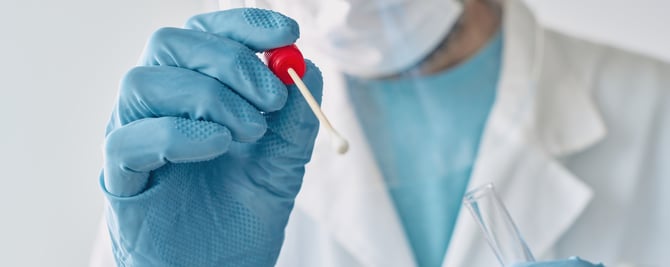IVD Testing for Marijuana and Other Drugs
An increased use in marijuana in the workplace means an increased use for drug screening.1
IVD testing uses tissue and fluid samples to detect the presence of a drug.1 Medix Biochemica provides reagents for use in many different types of drug detection tests, including those using urine, saliva, blood and even hair samples.1
How accurately can IVD tests show the timeframe in which marijuana was used?
This depends on whether the test is measuring the ‘parent drug’ (the non-metabolized version of the drug) or the metabolites of that drug:1
- Marijuana metabolites are found in urine and may be detectable for up to 30 days after use
- The ‘parent drug’, delta-9 tetrahydrocannabinol (THC), is found predominantly in the saliva and is usually only detectable for up to 24 hours after use
Because testing for the parent drug detects recent marijuana use, it’s a more reliable indication that someone might be impaired.1 This is why employers will typically opt for saliva-based marijuana testing when wanting to ensure that their employees aren’t impaired while doing hazardous work.1
|
Note: All drug-testing immunoassays are screening tests. Any positive result would need to be double-checked and confirmed with a more sensitive and precise assay, usually by mass spectrometry.1 |
How does Medix Biochemica help clients to develop accurate drug tests?
Medix Biochemica provides the antibodies and antigens (reagents) that are used to build accurate screening tests.1 These include reagents for detecting either parent drugs via saliva testing, or metabolites via urine testing.1
The two most important factors in IVD testing for marijuana and other drugs of abuse are:1
- To meet the cut-offs that are established
- To have little to no cross-reactivity with other substances in the sample
Medix Biochemica provides high-quality reagents that produce reliable results and do not cross-react with other substances.1 Some of these reagents are designed to specifically detect the presence of a parent drug, while others detect metabolites.
We also offer products for opioid testing, which can differentiate between prescription opioids and illegal drugs like heroin.1
|
For example, Medix Biochemica offers a reagent for specifically detecting the heroin metabolite 6-monoacetylmorphine (6-MAM), which is found in urine.1 This is more effective than testing for a metabolite like morphine, which isn’t specific to heroin and may show up in a sample due to legitimate prescription drug use.1 |
Drug use – and therefore drug testing – is always evolving, with new designer drugs coming onto the market regularly.1 At Medix Biochemica, we stay abreast of the latest developments in drug testing, to offer reliable testing reagents and biospecimens that meet our clients’ evolving needs.1
References:
- Expert opinion. Interview with Amy Moore, Product Manager at Medix Biochemica. May 18, 2023.
- United Nations Office on Drugs and Crime. World Drug Report Booklet 3: Drug market trends: cannabis, opioids. 2022.
- Quest Diagnostics. Drug testing index™ and industry insights. 2022.
- Cannabis use linked to higher injury risk, but only among those who use at or before work. Institute for Work & Health. Accessed June 27, 2023. https://www.iwh.on.ca/newsletters/at-work/108/cannabis-use-linked-to-higher-injury-risk-but-only-among-those-who-use-at-or-before-work.
- Lira MC, Heeren TC, Buczek M, et al. Trends in cannabis involvement and risk of alcohol involvement in motor vehicle crash fatalities in the United States, 2000‒2018. Am J Public Health. 2021;111(11):1976-1985. doi:10.2105/AJPH.2021.306466.
- Cannabis. World Health Organization. Accessed June 27, 2023. https://www.who.int/teams/mental-health-and-substance-use/alcohol-drugs-and-addictive-behaviours/drugs-psychoactive/cannabis.
- Pearlson GD, Stevens MC, D’Souza DC. Cannabis and driving. Front Psychiatry. 2021;12:689444. doi:10.3389/fpsyt.2021.689444.
- Benefits of drug testing. DISA. Accessed June 27, 2023. https://disa.com/drug-testing/benefits-of-drug-testing.
- McNeil SE, Chen RJ, Cogburn M. Drug testing. In: StatPearls. StatPearls Publishing; 2023.
- Azadfard M, Huecker MR, Leaming JM. Opioid addiction. In: StatPearls. StatPearls Publishing; 2023.






